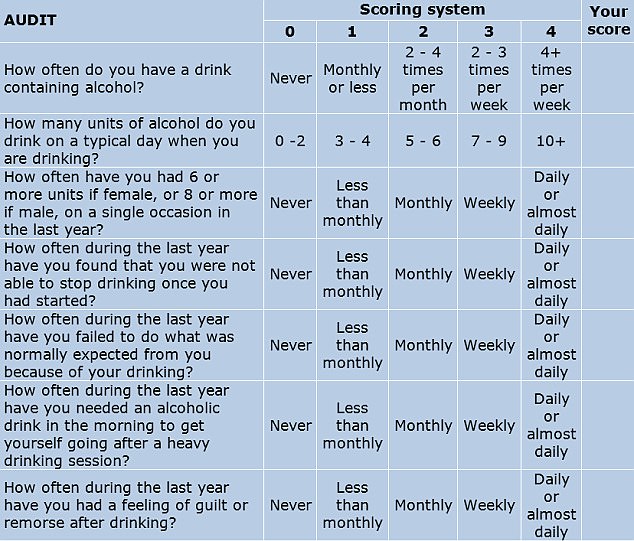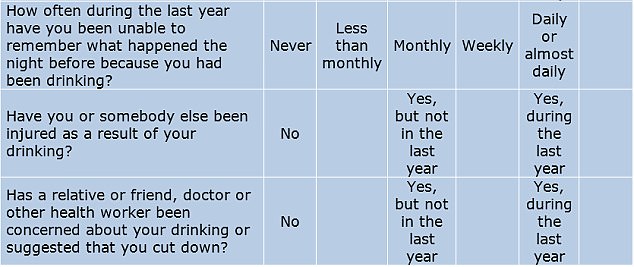Say goodbye to your big glass of wine! Getting pubs and bars to kill the 250ml benchmark will lead to an 8% drop in sales, find scientists who claim NO amount of drink is safe
It’s a question most people ask when ordering a glass of wine: small, medium or large?
But removing the largest portion – the 250ml option in most cases – could reduce the volume served at wine bars and pubs by around 8 per cent, a study suggests.
While this is only a modest measure, experts say it could be a way to encourage customers to drink less alcohol and improve the health of the population.
Alcohol consumption is the fifth leading cause of premature death and disease worldwide. According to the World Health Organization, the harmful use of alcohol led to approximately 3 million deaths around the world in 2016.
It’s a question most people ask when ordering a glass of wine: small, medium or large? But removing the largest portion – the 250ml option in most cases – could reduce the volume served at wine bars and pubs by around 8 per cent, a study suggests
Researchers from the University of Cambridge conducted their research in 21 licensed premises – mainly pubs – in England.
They removed the largest portion of wine glass for four weeks to see if this would affect the amount consumed.
The drink is the most consumed alcoholic drink in Britain and Europe. It is usually offered in three glass sizes: 125 ml, 175 ml and 250 ml.
Studies have shown that the introduction of the larger size, which began to become more popular in the 1990s, encourages drinkers to consume more.
Analysis published in the journal Plos Medicine found that removing the 250ml option led to an average drop of 420ml of wine sold per day per location – the equivalent of a 7.6 per cent drop.
There was no evidence that sales of beer and cider increased, suggesting that people were not compensating for their reduced wine consumption by drinking more of these alcoholic drinks.
There was also no evidence that this affected overall daily revenue, implying that participating pubs and bars did not lose money as a result – perhaps due to the higher profit margins from smaller glasses of wine.
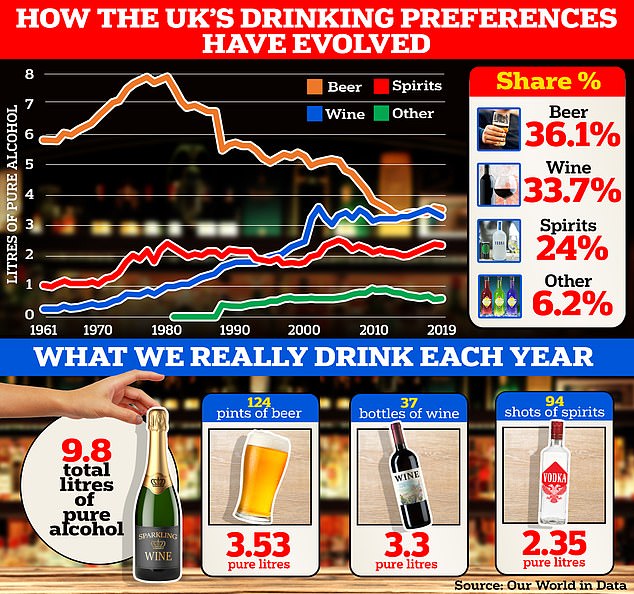
The latest data, collected by the World Health Organization and compiled by Oxford University-backed platform Our World in Data, shows that British wine consumption has risen to 3.3 liters of pure alcohol per year (2019), up from 0 .3 liters which was recorded almost 60 years earlier in 1961. It now accounts for over a third (33.7 percent) of all alcohol consumed across the country and is almost on par with beer (36 percent ), which has plummeted from 5.8 liters in 1961 to 3.5 liters today.
First author Dr Eleni Mantzari said: ‘It appears that when the largest portion of wine by the glass was not available, people switched to the smaller options but then did not drink the equivalent amount of wine.
‘People tend to consume a certain number of ‘units’ – in this case glasses – regardless of portion size.
“So a person might decide from the outset that they will limit themselves to a few glasses of wine, and with less alcohol in each glass they will drink less overall.”
According to the researchers, removing the largest serving glass would potentially be acceptable to pub or bar managers as there is no evidence this could result in a loss of revenue, a national policy likely to be resisted by the alcohol industry given its size . potential to reduce sales of targeted beverages.
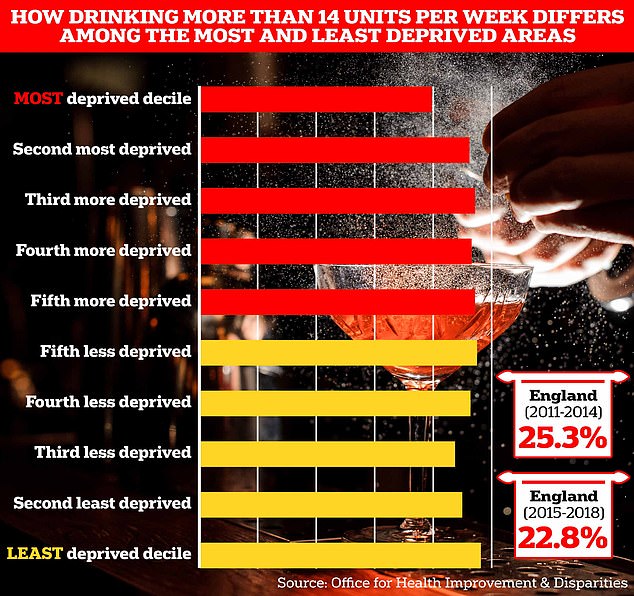
On average, one in five Britons (22.8 percent) – roughly 9.4 million – exceeds the weekly NHS recommendation, official data shows. However, this rate has fallen, compared to one in four adults consuming more than 14 units per week between 2011 and 2014. But the highest rates of alcohol consumption are in the least deprived areas, with the least socio-economically deprived decile recording a figure of 24.1. per cent
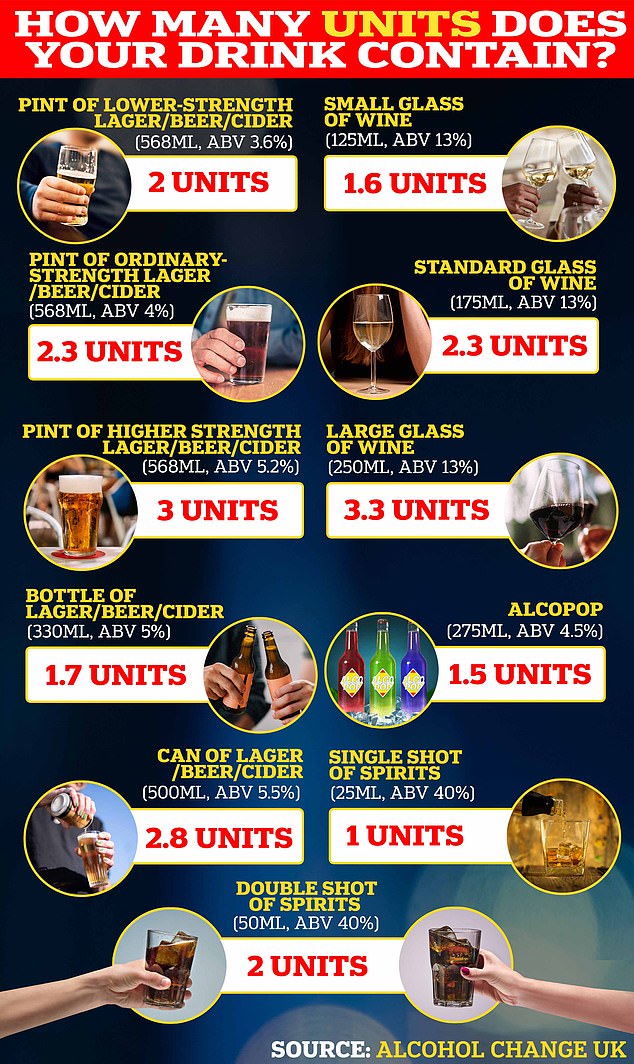
The NHS recommends people drink no more than fourteen ‘units’ of alcohol – around six glasses of wine or pints of beer – per week. This has been diluted in recent decades in light of studies illustrating the health hazards of alcohol
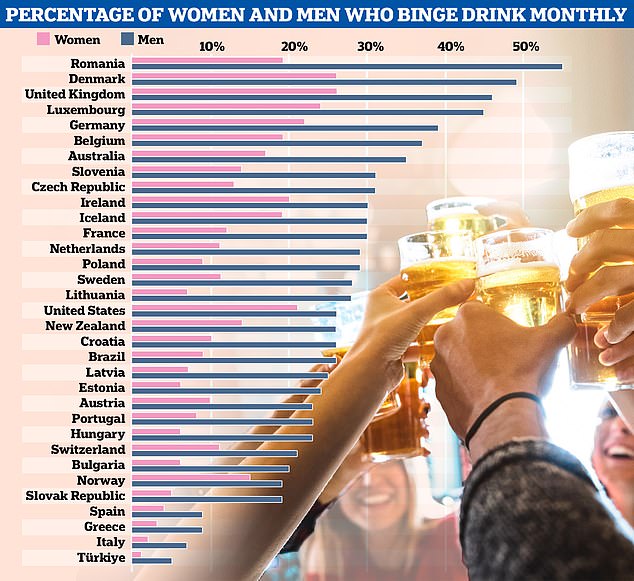
According to OECD data released last year, almost one in five adults reported binge drinking at least once a month, on average across 29 OECD countries in 2019. This figure varies tenfold, from less than 3 percent in Turkey to more than 30 percent. percent in Germany, Luxembourg, Great Britain and Denmark
Public support for such a policy would depend on its effectiveness and the extent to which it was clearly communicated.
Professor Dame Theresa Marteau, lead author of the study, said: ‘It is worth remembering that no alcohol consumption is considered safe for health, with even light consumption contributing to the development of many cancers.
‘Although the reduction in the amount of wine sold at each site was relatively small, even a small reduction could make a meaningful contribution to public health.’
There is evidence that the public prefers information-based interventions, such as health warning labels, over reductions in portion or package sizes.
In this study, managers at four of 21 locations reported receiving customer complaints.

